
Sandy Loam Upland 8-12" p.z.
Scenario model
Current ecosystem state
Select a state
Management practices/drivers
Select a transition or restoration pathway
- Transition T1A More details
- Transition T2A More details
- Restoration pathway R3B More details
- Restoration pathway R3A More details
- Transition T3A More details
- Restoration pathway R4A More details
-
No transition or restoration pathway between the selected states has been described
Target ecosystem state
Select a state
Description
Native Grass-Shrub State has two Community Phases that fluctuate with dry/wet weather cycling. The Reference Plant Community (CP1.1) is a an open community of perennial grasses and desert shrubs and cacti. Annual forbs and grasses, of both the winter and summer wet seasons, are very important in the plant community in their respective (wet) seasons. Tobosa, black grama and bush muhly are the dominant perennial grasses, with lesser amounts of perennial mid-grasses such as threeawns and dropseeds. The cover of some shallow rooted grass species, like curly mesquite and Rothrock grama fluctuate widely from wet to dry years. Climate fluctuations, cycling of wet winters, favors shrub growth thus allowing the shrub dominance in CP1.1; extended drought will contract both perennial grass and shrub canopy covers, transitioning the community phase to CP1.2. Natural fire may occasionally occur in this LRU but is not thought to have recurred with a frequency to shape this plant community.
Submodel
Description
Non-Native Grass State, is a cyclic large shrub-annual forbs / large shrub-Lehmann lovegrass plant community. Community Phase 2.1 persists for about 10 years following brush management combined with range seeding. The restoration from State 3, prescribed grazing without brush management, will result in CP 2.2 with Lehmann lovegrass in the soil seedbank. The prevalence of Lehamnn lovegrass within the soil seedbank no longer requires range seeding. Once a soil seedbank is established, LL will persist in the plant community while its basal cover varies widely with climate, elevation, depth of surface soil over argillic. Lehmann lovegrass only dominates the entire plant community in CP 2.1, after brush management and seeding, but it will dominate the herbaceous layer of the plant community once established. Lehmann lovegrass production does not exceed 400# / ac during Non-Native lovegrass cycles.
Submodel
Description
Large Shrubs-Annuals, comes about after years of heavy grazing. Suffrutescent grasses are confined to tightly protected areas within shrub and cactus canopies leaving large bare areas as inter-shrub spaces.
Submodel
Description
Large Shrubs, Eroded, has active, accelerated erosion. This state occurs where mesquite canopy is heavy (15-25%) and the interaction of drought and continuous grazing has resulted in severe sheet, rill and, in some cases, gully erosion on the site.
These areas are usually near historic watering locations and are characterized by soil compaction due to trailing and heavy livestock traffic.
Submodel
Mechanism
yearlong, heavy livestock grazing without native grass management
Mechanism
prescribed grazing, non-native seed introduction, brush management
Mechanism
yearlong, heavy livestock grazing without native grass management
Model keys
Briefcase
Add ecological sites and Major Land Resource Areas to your briefcase by clicking on the briefcase (![]() ) icon wherever it occurs. Drag and drop items to reorder. Cookies are used to store briefcase items between browsing sessions. Because of this, the number of items that can be added to your briefcase is limited, and briefcase items added on one device and browser cannot be accessed from another device or browser. Users who do not wish to place cookies on their devices should not use the briefcase tool. Briefcase cookies serve no other purpose than described here and are deleted whenever browsing history is cleared.
) icon wherever it occurs. Drag and drop items to reorder. Cookies are used to store briefcase items between browsing sessions. Because of this, the number of items that can be added to your briefcase is limited, and briefcase items added on one device and browser cannot be accessed from another device or browser. Users who do not wish to place cookies on their devices should not use the briefcase tool. Briefcase cookies serve no other purpose than described here and are deleted whenever browsing history is cleared.
Ecological sites
Major Land Resource Areas
The Ecosystem Dynamics Interpretive Tool is an information system framework developed by the USDA-ARS Jornada Experimental Range, USDA Natural Resources Conservation Service, and New Mexico State University.
